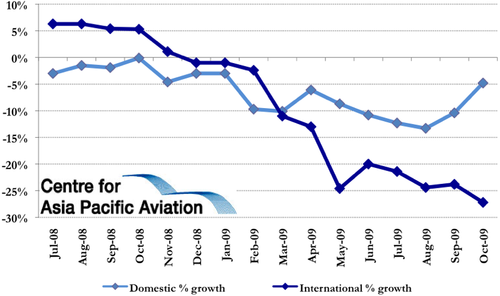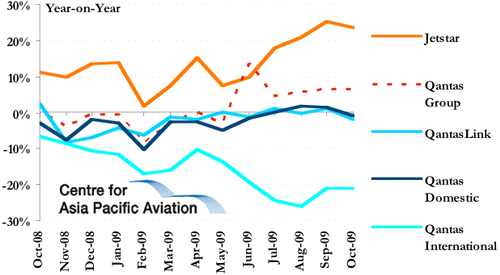No end in sight for Qantas’ international yield reductions; domestic yields on the improve
Qantas reported continued yield weakness in Oct-2009, total international yield continuing its slump, falling 27.2% (for the largest reduction in over 16 months) and indicating that there is no end in sight for the carrier's international yield decline. However, domestic yields are showing signs of improvement, down by only 4.8%, for the smallest contraction since Jan-2009.
Qantas Group yields (excluding foreign exchange): total domestic (Qantas, QantasLink and Jetstar Domestic) and total international (Qantas and Jetstar International): Jul-2008 to Oct-2009
Earlier this month, Qantas CEO, Alan Joyce, stated the carrier was "not seeing an improvement in business traffic", with yields "still depressed internationally". Mr Joyce added that lower yields would ''take some time to wash out of the system" as the carrier still has "a lot of cheap air fares in our inventory".
On a more positive note, Mr Joyce stated leisure demand is improving, enabling the carrier to increase its domestic fares, as reflected in the improved yield figures. This improvement is likely to continue, with Qantas and QantasLink increasing domestic fares by up to AUD10 a sector on 14 key routes from 01-Dec-2009, the largest increase for the Group since the start of the global financial downturn in 2008. The Group stated the increase was ''just part of our periodic review of fares''.
Load factor improvements a positive
In more positive news, Qantas Group load factors increased 3.4 ppts year-on-year to reach 83.3% in Oct-2009, as the Group reduced capacity (ASKs) by 1.1%. Group passenger numbers were also up by 6.7% year-on-year to 3.8 million, as traffic (RPKs) increased 3.2% in the month.
Importance of Jetstar shining through
Qantas Group's Oct-2009 traffic results also clearly illustrate the importance of Jetstar to the Group's operations. During the month, combined Jetstar Domestic and International passenger numbers (1.1 million, +23.6% year-on-year) represented 30% of total Group passengers, and 20.1% of total capacity (ASKs).
The Group's 6.7% increase in passenger numbers in the month was driven purely by Jetstar, with a 3.6% increase in Jetstar domestic passengers, and a massive 116% increase in Jetstar International passenger numbers. Comparatively, Qantas Domestic, QantasLink and Qantas International all witnessed passenger reductions, of 0.9%, 1.9% and 20.9%, respectively. (The identical trend was witnessed for traffic (RPKs) and capacity (ASKs) in the month).
Qantas Group passenger numbers growth: Oct-2008 to Oct-2009

